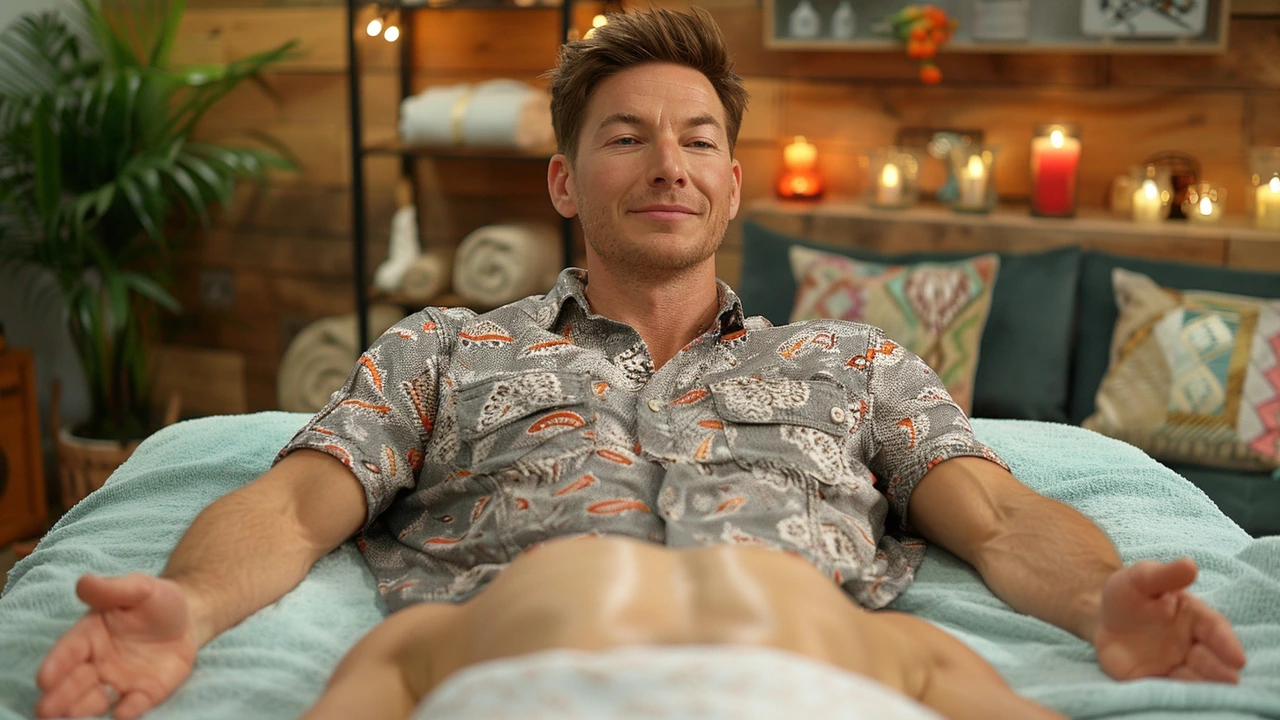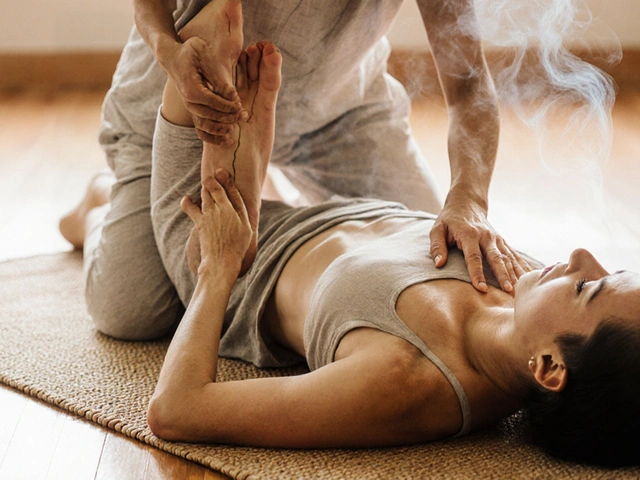Blind Massage: Discovering a Unique Sensory Experience for Optimal Relaxation

Blind massage, an intriguing and increasingly popular wellness practice, is more than a mere relaxation technique.
Originating from Eastern traditions, it has evolved to be a compelling blend of sensory enhancement and therapeutic touch. By relying on their heightened sense of touch, blind massage therapists provide a unique and deeply attentive form of massage.
Elevated by their sensitivity, the experience can lead to a profound sense of relaxation and mindfulness. Dive into this innovative approach and discover how it can contribute not just to physical relief but also to your overall well-being.
- Origins of Blind Massage
- The Philosophy Behind It
- Benefits for Mind and Body
- What to Expect During a Session
- Techniques Used
- Tips for Maximizing the Experience
Origins of Blind Massage
The history of blind massage is a fascinating journey that blends cultural traditions, necessity, and the profound human ability to adapt. This practice is rooted in ancient China, where visually impaired individuals were often employed as masseurs due to their heightened sense of touch. Over centuries, this unique form of massage has evolved, spreading its benefits globally.
In the Ming and Qing dynasties, blind massage gained significant recognition. People believed that the loss of sight enhanced other senses, especially touch. This led to the development of rigorous training programs for the visually impaired, focusing on anatomy, pressure points, and different massage techniques. A quote from a well-known Chinese proverb states,
"When one loses the vision of the eyes, the heart's vision becomes clear."
The Chinese government formalized blind massage practices in the mid-20th century, establishing specific schools and certifications for blind therapists. Japan also embraced the tradition, integrating it into their own massage techniques such as Shiatsu. Historically, these practices were not just about relaxation but were seen as an essential element of traditional medicine. In recent years, countries like Thailand, South Korea, and Malaysia have adopted and adapted these practices too.
An interesting fact is the way society views blind massage therapists. In many cultures, they are revered not just as healers but as individuals who have turned a disability into a profound strength. Countries like China and Japan have specific institutions dedicated to training the visually impaired in the art of massage, ensuring that this ancient practice continues to thrive in modern times.
As with any tradition steeped in history, blind massage has its share of challenges and triumphs. Technological advances and modern medical practices have both competed with and complemented traditional massage techniques. Yet, despite the changing landscape, blind massage remains a testament to human adaptability and the pursuit of wellness.
The Philosophy Behind It
The practice of blind massage is grounded in the belief that when one sense is limited or removed, other senses become more acute. This philosophy is rooted in centuries-old Eastern medicine, where the concept of heightened sensory perception is embraced. Blind massage therapists, often trained in specialized schools, use their enhanced touch to locate problem areas that might be overlooked by sighted therapists.
This philosophical approach argues that the absence of visual distraction allows the practitioner to connect on a deeper level with the client's bodily cues. A blind masseur's training is rigorous and comprehensive, ensuring they can navigate the body using techniques that are both intuitive and methodical. This method challenges the conventional reliance on sight as the primary sense in therapeutic practices.
Various studies have bolstered this philosophy. Research published in the Journal of Alternative and Complementary Medicine, for instance, revealed that blind therapists often develop extraordinary tactile sensitivity. Such sensitivity enables them to detect subtle muscular and tissue changes, offering an experience that many find unparalleled. As Helen Keller famously said, “The best and most beautiful things in the world cannot be seen or even touched - they must be felt with the heart.”
Moreover, the philosophy behind blind massage isn't merely theoretical or anecdotal. It's proven by the outcomes clients experience, with many reporting a sense of being truly understood and attended to. This approach rests on the assumption that every part of the human body communicates its needs through texture, temperature, and tone, which can be felt more potently when not overshadowed by visual input. Hence, blind massage therapists might interpret the body's language more effectively.
In practical terms, the service provided isn't diminished by a lack of sight; if anything, it is enriched. This philosophical underpinning promotes a unique form of trust between the client and the therapist, where the latter relies on finely tuned sensory feedback. It's a dynamic interplay where the client's experience of touch is heightened, and the therapist's sensitivity is their guiding light. This kind of mutual trust and heightened sense of touch often results in deep relaxation and therapeutic benefits.
Benefits for Mind and Body
Blind massage offers a wealth of benefits for both the mind and body. This unique therapy harnesses the heightened tactile senses of blind massage therapists, providing an exceptionally attentive and personalized treatment. Due to their heightened sense of touch, blind therapists can detect and address muscle tension with remarkable precision, resulting in more effective relief from physical stress and pain.
One of the main benefits of blind massage is its ability to promote deep relaxation. By focusing almost entirely on the sense of touch, clients are encouraged to slow down and become more mindful of their bodies. This enhanced awareness can lead to a significant reduction in stress levels, as the mind is given a break from the constant bombardment of visual and auditory stimuli. The tranquil atmosphere of a blind massage session allows the mind to unwind, and the body to release built-up tension.
In addition to its relaxation benefits, blind massage can also improve circulation. The careful and deliberate movements of the therapist help to stimulate blood flow, which can aid in the delivery of oxygen and nutrients to muscles and tissues. Improved circulation can also help to speed up the healing process for injuries and reduce inflammation. Additionally, this type of massage has been known to enhance lymphatic drainage, assisting in the removal of toxins from the body.
For those with chronic pain conditions, blind massage can offer substantial relief. The precise and intuitive touch of blind therapists allows them to identify and target specific areas of discomfort effectively. Studies have shown that regular massage therapy can help manage the symptoms of conditions such as fibromyalgia, arthritis, and lower back pain. By alleviating pain and discomfort, clients find themselves able to move more freely and participate more fully in their daily activities.
Blind massage also has mental health benefits. The deep relaxation and meditative state that clients often experience during a session can reduce symptoms of anxiety and depression. The tactile focus of the therapy encourages clients to be present in the moment, fostering a sense of mindfulness and inner peace. This practice can help to break the cycle of negative thoughts and stress, leading to improved emotional well-being.
Moreover, the profound human connection that is often established during a blind massage session can have a lasting impact. Clients may feel a sense of trust and empathy with their therapist, contributing to an enhanced sense of emotional support and understanding. This human connection can be particularly beneficial for individuals who may feel isolated or disconnected in their daily lives.
"The benefits of massage therapy for mental health are well-documented. Massage can significantly reduce levels of cortisol, the stress hormone, and increase levels of serotonin and dopamine, which contribute to feelings of well-being." - American Massage Therapy Association (AMTA)
In essence, blind massage is a holistic therapy that touches both mind and body in profound ways. The sensory journey not only provides immediate relaxation and pain relief but also fosters long-term emotional and physical health. Whether seeking solace from chronic pain, relief from stress, or simply a unique and rejuvenating experience, blind massage offers a compelling option for holistic well-being.
What to Expect During a Session
Stepping into a blind massage session can be a unique experience right from the beginning. From the moment you walk into the tranquil room, you’ll notice the ambiance is carefully designed to promote relaxation. Soft lighting, calming scents, and gentle music set the stage.
As the session begins, the therapist will take a few minutes to discuss your preferences and any areas of tension you might have. Communication is key, even when the therapist cannot see. Their heightened sense of touch allows them to detect subtle muscular anomalies and stress points that might be overlooked by sighted therapists. Don't be surprised if you feel a greater connection and attentiveness during the massage.
The massage itself often starts with long, sweeping strokes to warm up the muscles. Given the reliance on touch, a variety of techniques might be used—from kneading and pressure point therapy to gentle stretching. As one experienced practitioner put it,
“Our touch is our vision. Every muscle, every sinew tells us a story of tension and relief.”
During the session, be prepared for a multi-sensory experience. Some therapists use calming essential oils or incorporate elements like hot stones. This holistic approach not only targets physical tension but also addresses mental and emotional stress.
Many clients report feeling a deep sense of relaxation, often drifting into a meditative state. The lack of visual distraction enhances the sensory focus, making every touch more pronounced. As your session progresses, you might notice your mind quietening, a state akin to mindfulness.
The session usually concludes with a brief period of rest. This 'integration time' allows your body to absorb the benefits of the massage fully. When you finally get up from the table, it’s common to feel a sense of rejuvenation, both mentally and physically.
To sum up, a blind massage is a journey of profound sensory engagement. It’s about more than just addressing muscle knots; it's about reaching a state of holistic well-being. If you’ve never tried it, you might find it a remarkably transformative experience.
Techniques Used
Blind massage therapists employ a variety of techniques that are deeply rooted in traditional practices, yet are fine-tuned by their heightened sense of touch. One common method used is Swedish massage, which involves long, gliding strokes in the direction of blood returning to the heart. This technique is incredible for enhancing blood circulation and providing a general sense of relaxation.
Another prevalent technique is deep tissue massage. This method focuses on realigning deeper layers of muscles and connective tissue. These slow and deliberate strokes, combined with deep finger pressure, help to ease chronic tension and pain. Due to their exceptional tactile ability, blind therapists can effectively locate and address knots and tight spots in the muscles.
Shiatsu is also a key technique utilized in blind massage. Originating from Japan, Shiatsu employs the use of finger pressure on specific points across the body. These points correspond to the body's meridians, which are believed to be pathways for energy flow. By applying pressure, therapists aim to balance and restore the energy within the body, promoting overall wellness.
Beyond these widely known methods, blind massage therapists often engage in customized treatments that combine elements of various techniques. They are particularly attuned to the feedback from a client's body, enabling them to adapt and modify their approach as needed. The use of aromatherapy oils is common, adding an additional sensory layer to the experience. These oils can include lavender for relaxation, peppermint for invigoration, or eucalyptus for respiratory benefits.
A unique aspect of blind massage is the emphasis on sensory experience. Therapists might integrate elements such as soft music or sound bowls to create a serene atmosphere. It is not uncommon for sessions to include guided breathing exercises as a means to foster deeper relaxation. This holistic approach aims to engage all the senses, providing a more immersive and fulfilling experience.
"Blind massage therapists have an innate ability to connect with their clients on a deeply personal level," says Dr. Sarah Jenson, a renowned physiotherapist. "Their enhanced tactile perception allows them to deliver a level of care that is both intuitive and highly effective."
For those looking to try blind massage, it is helpful to understand the types of equipment commonly used. Massage tables with adjustable height features ensure optimal positioning. Heated blankets and warm towels are often incorporated to help relax muscles and enhance comfort. In some cases, therapists might use specialized tools such as massage balls or rollers to assist in the treatment.
In essence, the techniques used in blind massage are a harmonious blend of traditional methods and personalized adjustments. This unique synthesis not only addresses physical ailments but also contributes to mental and emotional wellness, making it a truly holistic healing experience.
Tips for Maximizing the Experience
Enhancing your blind massage session begins before you even step into the spa. Preparation can amplify the therapeutic benefits and ensure a more profound sensory journey. Here are some effective tips to help you get the most out of your blind massage experience:
Set Your Intentions
Before your session, take a few moments to set your intentions. This isn’t just about stating you want to relax. Be specific about what you hope to achieve. For instance, you might want to focus on releasing tension in your shoulders, or perhaps you’re seeking emotional clarity. Clear intentions can help your therapist tailor the session to meet your needs more precisely.
Communicate Openly
While the idea of blind massage might seem centered around the therapist's heightened touch, your communication remains vital. Share any specific areas of discomfort or tension you’re experiencing. If you’ve had injuries or recent surgeries, your therapist needs to know to avoid those areas or apply appropriate pressure. Don't hesitate to speak up during the session if the pressure feels too intense or too light. The more information they have, the better they can serve you.
Embrace the Sensory Deprivation
One beautiful aspect of blind massage is the ability for the receiver to embrace sensory deprivation. This can heighten other senses and deepen the relaxation experience. Consider closing your eyes during the session and focusing on the rhythm of the therapist's movements. Mindfulness experts suggest that being present in the moment can significantly enhance the therapeutic effects of massage.
“When you surround yourself with utter darkness or close your eyes, all your other senses naturally become more attuned,” shares Mindfulness Coach Dr. Anne Stevens. “This principle makes blind massage an extraordinary mindfulness exercise.”
Relax and Breathe
Sounds simple, yet many people unknowingly hold their breath while undergoing massage. Conscious breathing can play a huge role in maximizing relaxation. Deep, consistent breathing can help relax muscles and send calming signals throughout your body. Try techniques like inhaling deeply for four seconds, holding for four seconds, then exhaling slowly. Consistently focusing on your breath can also anchor your mind, preventing it from wandering into stress or distraction.
Hydrate Before and After
Hydration is crucial for any massage therapy. Drinking water before your session ensures your muscles are well-hydrated, making them more pliable and responsive to treatment. Post-massage, water helps flush out any toxins released during the therapy. Some therapists believe that proper hydration can reduce soreness and improve recovery time, making the session's benefits last longer.
Follow Up with Self-Care
Blind massage can have lasting effects if complemented by proper self-care. After the session, consider taking a warm bath to maintain muscle relaxation. Gentle stretches can also help keep the muscles limber and support the work your therapist accomplished. Balance activities that demand physical exertion with moments of rest. This balance will help your body fully integrate the therapy benefits.
In the end, blind massage offers an opportunity for holistic rejuvenation, touching both body and mind in a uniquely profound way. By following these tips, you can maximize the benefits of your sessions, resulting in deeper relaxation and enhanced well-being.





